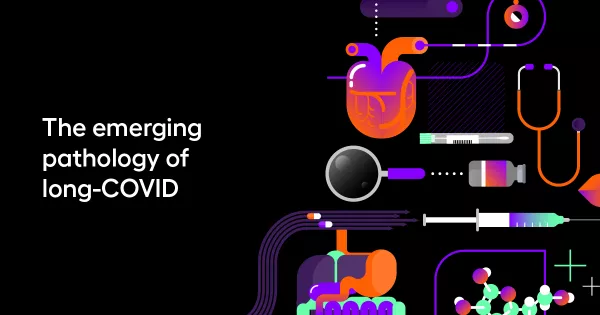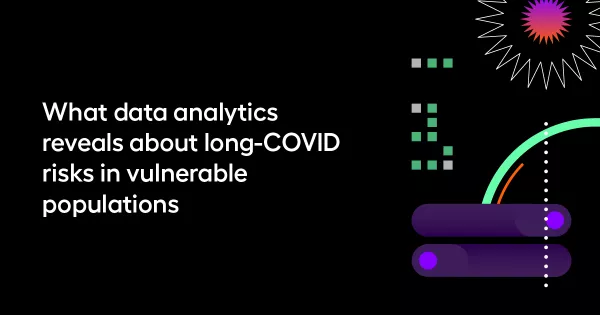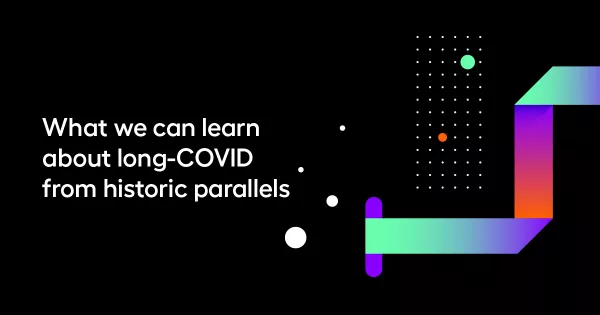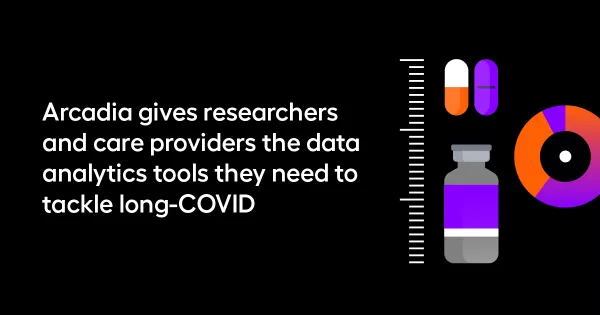Can data help eradicate long-COVID?
In the effort to treat long-COVID, healthcare data and predictive analytics gives us a hopeful path forward.
The pandemic cast a shadow over the last few years, and this spring’s Health Datapalooza, a conference where data obsessives and health experts meet, was no different. In a panel on long-COVID, Matthew Zachary, CEO and co-founder of OffScrip Health, posed a series of questions to experts across fields.
Arcadia Chief Medical Officer Dr. Rich Parker brought his keen eye for data in clinical medicine, while Dr. Ziyad Al-Aly, Director of the VA Saint Louis Health Care System’s Clinical Epidemiology Center, dug through real-world discoveries his network has made via patient treatment. Christine Von Raesfeld brought an especially important perspective to this roundtable: that of both a patient advocate (as founder and CEO of People With Empathy) and as a patient herself, having battled long-COVID and other autoimmune conditions that made her particularly vulnerable to the pandemic’s dangers.
As these experts tried to make sense of an emergent diagnosis, they discussed the disease’s impact, the evidence surrounding it, and what solutions might arise from comprehensive data analytics. Read on for the wisdom they dug out of an overwhelming tragedy — and the insights that give hope for a healthier future.

The emerging pathology of long-COVID
In contrast to the variants whose names made headlines, long-COVID emerged more slowly, with less clarity. It took tracking the disease’s progression to realize that a good portion of people diagnosed with COVID didn’t shed their symptoms as soon as they recovered. Early on, confused messaging plagued everyone from media outlets to clinicians.
“Everybody, at the time, was telling us and telling patients that if you get COVID, if you’re young and healthy, a week or two at the most and you’ll recover. You get over it, and it’s all behind you,” Dr. Al-Aly said.
Long-COVID affects everyone from the “young and healthy” to immunocompromised patients like Von Raesfeld, whose auto-immune dysfunction rendered her vaccinations useless.
Data shows a significant group of Americans are at risk for long-COVID, whose symptoms vary dramatically from patient to patient. According to Dr. Parker, it’s estimated that 1 in 3 people in the US have had COVID, or about 100 million people. Of those, 10-20% of patients are expected to experience long-COVID symptoms, which leaves a minimum of 10 million people afflicted by these ongoing symptoms.
This is a problem that demands robust data and predictive healthcare analytics.

What data analytics reveals about long-COVID risks in vulnerable populations
Like any emergent disease, our understanding of long-COVID is evolving. All the different manifestations are grouped under this umbrella diagnosis that might really be multiple pathologies — subsets of a disease. Think of cancer: prostate cancer is different than lung cancer or breast cancer, the same way someone’s long-COVID could look like high blood pressure versus brain fog.
Healthcare data shows certain groups appear to be most at-risk. People with pre-existing auto-immune issues like diabetes are one such population, as well as people with active Epstein-Barr virus (the same kind that causes mononucleosis) at the same time they contract COVID-19.
There are some theories around why long-COVID happens at all, and they run the gamut. Some say it’s an ongoing, low-level viral infection, incubated in the body. Others theorize an immune response gone haywire. It could also be microclots in organs and tissues, or even an effect on mitochrondrial function at the cellular level.

What we can learn about long-COVID from historic parallels
When it comes to predicting the future, other diseases’ histories might be the ticket to understanding long-COVID. Predictive analytics in healthcare might bridge the gap between past and present.
Dr. Parker remembers the initial controversy around chronic fatigue syndrome, which some members of the medical community were quick to dismiss.
“Some of the effects of chronic fatigue syndrome are very similar to COVID. For example, if people try to exercise, they feel worse,” he said. “We’re all trained and told that it helps. ‘Work hard. Be tough. Exercise through it.’ That’s bad advice for long-COVID, and bad advice for chronic fatigue syndrome.”
Pandemics have sprung up throughout history, worldwide. One common comparison is the Spanish flu in 1918, which hit on a similarly global scale. “Long-flu” isn’t commonly used, but according to Dr. Al-Aly, it’s real, and very similar to long-COVID.
“The broad idea that our viral illnesses lead to long term consequences isn’t necessarily new, but it was understudied,” he said. “They didn’t have the technology at that time to really study at a massive scale like we do now. This is why we have a greater recognition of long-COVID, versus a very rudimentary recognition in the early 20th century of long-flu. That’s thanks primarily to advances in science, including advances in data and data systems that allow us to unlock insights into disease mechanisms, epidemiology, and manifestations of disease.”
We can look to history for critical mistakes — like dismissing patients’ suffering — and we can see how diseases affect different communities.
But the key difference in the era of COVID is data. The aggregation and organization of patient records is what differentiates our 21st century response from earlier pandemics, and it’s what will give us the tools to better recovery.

Where data shows hope for a long-COVID cure
From data analytics to defeating disease
The first step towards banishing long-COVID once and for all? Information, shared and accessed with ease.
One critical issue we’ll need to overcome if long-COVID’s going away is getting clinicians across the country on the same page. Especially in the current pandemic, best practices change as new information is discovered, and the flow of information (from study to provider to the general public) can be more of a trickle than a reliable pipeline.
Long-COVID is an emerging diagnosis with lots of moving pieces. Physicians need education and training on the disease and its ramifications, and Dr. Parker recommends tools like UpToDate, a repository of evidence and clinical data that helps guide decision-making. Arcadia’s healthcare data platform fills a similar need: lots of information, organized and processed to help researchers and care providers draw meaningful conclusions.
Even equipped with the latest, greatest data, empathy is a problem clinicians will need to reckon with. It could start with better training and education.
“Maybe it’s not the right context to discuss medical gaslighting, but there is some of that in the medical community,” Dr. Al-Aly said. “It has an enormously deleterious effect on patients — patients generally tend to disengage, you know? They stop seeking care, and it really has very harmful consequences.”
This is something Von Raesfeld dealt with firsthand, and it reflects the experiences of many chronically ill patients. She often found herself in the position of learning about new treatments and bringing those to her physicians, advocating on her own behalf.
Empathy extends beyond our national borders. And stamping out COVID globally is to Americans’ advantage, too.
“To the extent that we can share vaccine technology, for example, at a reasonable cost globally, it’s going to be good for everybody in the world,” Dr. Parker said. “Because guess what: if we don’t do that, COVID is going to continue to spread, mutate, and come back right back around the globe.”
How predictive healthcare analytics can shape policy and help populations
To eradicate long-COVID entirely, healthcare and public policy experts will need to fight on multiple fronts. The information should flow freely, the discoveries be shared widely, and the messaging consistent.
“We have all these different silos around the country working on things,” Dr. Parker said. “It’s good that people are working on things, but we need a better way to get the data together.”
The good news? COVID-19 is more transmissible than the flu, but less transmissible than measles, which are mostly a thing of the past.
“If we can control measles, which we can, we can also control COVID,” he added.
Predictive healthcare analytics are perhaps the strongest tool in our arsenal for fighting long-COVID.
MedRXIV surfaces emerging insights before they’ve had peer review — a time-consuming process — so that vital information is public. Real-world data (from electronic health records, claims data, insurer info, patient wearables, and elsewhere) also hold promise. It’s in combining, aggregating, and quickly assessing these information feeds — as Arcadia’s data analytics platform makes possible — that we have the best chance of a healthy population.
“We don’t have time to do randomized controlled trials for every single thing we need to figure out,” Dr. Parker added. “They take years; we don’t have years.”

Arcadia gives researchers and care providers the data analytics tools they need to tackle long-COVID
It won’t be an easy road, but we’d like to believe that determination plus a wealth of information could turn long-COVID into a thing of the past. In the meantime, you can access a wealth of coherent, contextualized data, so that whatever problems arise, your organization can meet them head-on.
Download our long-COVID white paper to learn more about how we’re putting data to work to solve this timely challenge.
